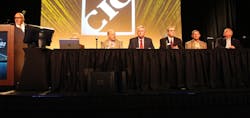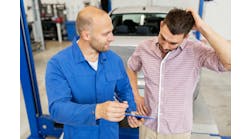DETROIT, July 22, 2015—Collision repair education and training is at an embarrassing low and the industry as a whole needs to take ownership of the problem and work toward improvement, according to a panel that discussed the topic at the Collision Industry Conference.
The panel included Jeff Peevy, president of the Automotive Management Institute; Mike Anderson, owner of Collision Advice; Mark Olson, president of Future Forensics; Jerry Goodson, instructor at Fox Valley Technical College, and Mark Woirol, research senior manager for Allstate’s Tech-Cor Applied Research.
I-CAR’s Gene Lopez, who co-chairs the CIC education and training committee with Bob Keith, multi-store director for CARSTAR, kicked off the discussion by referencing an alarming statistic: two-thirds of shops do not have consistent training. He also ran through other jarring slides that reinforced the lack of training, such as one that showed that 79 percent of techs who weld have not received basic I-CAR welding certification, 82 percent aren’t trained on squeeze-type resistance spot welders, and 93 percent are not certified for welding advanced structural steel.
The big question that the panel and the audience weighed in on: what to do about it.
Peevy and others emphasized that it’s not just the shops that should be singled out for being behind on training—it’s the responsibility of all industry stakeholders.
“I have to say that as an industry, we own this. We should be ashamed of this,” he said. “It’s not just the collision repair shops, it’s all of us that should be involved in this. It takes time, it takes resources to train your technicians, it takes all of us to acknowledge that.”
He said industry stakeholders in all segments need to ask themselves whether they are contributing to the problem or providing a solution.
One audience member asked how to embed a culture of learning into shops, noting that at present, one of the only drivers is whether requirements are being met to be on a DRP program.
Goodson said he stresses to students that the learning shouldn’t stop when school is done, that lifelong learning is a requirement of the job. His school, Fox Valley Technical College in Appleton, Wis., also offers continuing education to keep professionals up to speed.
Anderson suggested making training more interactive and accessible—tapping into e-learning modules, for instance. He also suggested emphasizing training options beyond I-CAR and motivating technicians by showing what happens when they don’t train, showing that they have real skin in the game when it comes to ensuring quality and safety.
“My dad used to have a saying you can lead a horse to water, but you can’t make them drink,” Anderson said. “And my dad used to say you have to put salt in their food and make them thirsty and if you do they’ll drink all day. We’ve gotta put salt in their food and make them thirsty.”
Lopez asked about the effectiveness of mandates in training. Peevy said what the industry really needs to recognize is the “silent mandate,” that technology is advancing at such a rapid clip that shops need to be learning to do their jobs properly. He emphasized a distinction between training and learning.
“We talk a lot about training,” he said. “The fact of the matter is we should be talking about learning. It just happens that training is one method we use to learn. But it is truly when someone learns something that things get better.”
Lopez said the education and training committee would continue the discussion about how to raise the bar for industry education and provide further insight into the state of collision education at future meetings.




